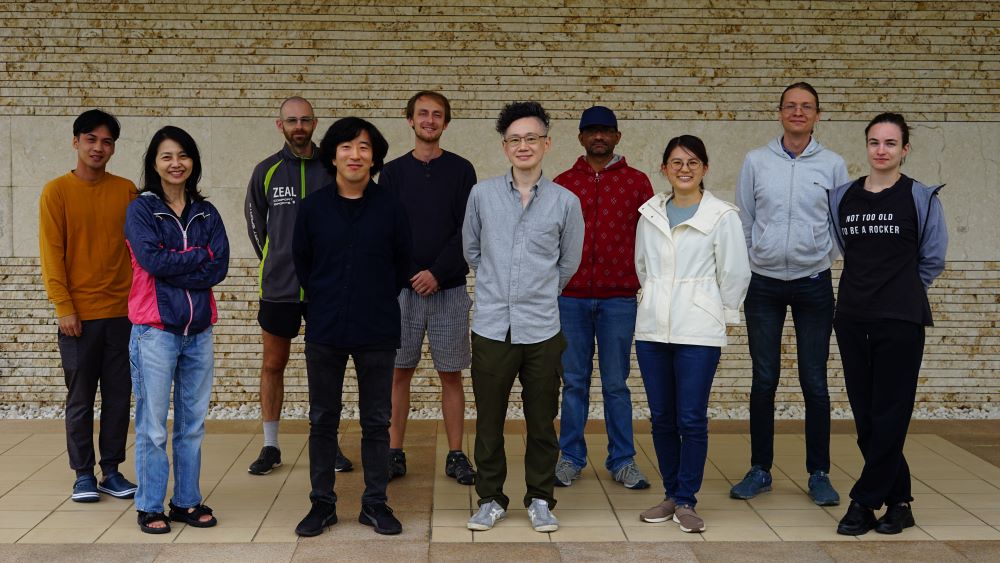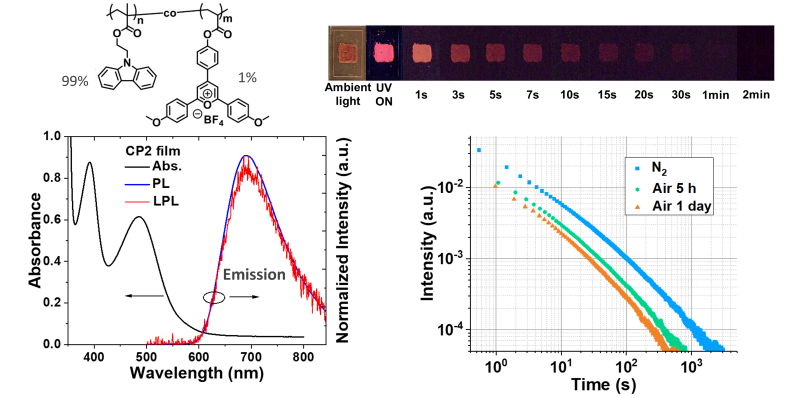FY2023 Annual Report
Organic Optoelectronics Unit
Assistant Professor Ryota Kabe

Abstract
In FY2023, we developed copolymers and dendrimers as part of our efforts in charge separation material development. Additionally, we worked on constructing new charge separation mechanisms. We welcomed three new postdoctoral researchers: Ryoko Ohyama, Dominik Madea, and Ruttapol Malatong. We also welcomed rotation students Yuxiang Guan and Kaede Kawaguchi.
1. Staff
- Kirill Mitrofanov, Staff Scientist
- Sri Lakshmi Venkata Narayana Yemineni, Postdoctoral Researcher
- Liliia Moshniaha, Postdoctoral Researcher
- Ryoko Oyama, Postdoctoral Researcher
- Dominik Madea, Research Fellow
- Ruttapol Malatong, Postdoctoral Researcher
- Rengo Yoshioka, Student
- Dmitry Kovalevskiy, Student
- Yuxiang Guan, Rotation Student
- Kaede Kawaguchi, Rotation Student
- Emiko Aasato, Administrator
2. Collaborations
2.1 Development of organic long persistent luminescence systems
- Type of collaboration: Joint research
- Researchers:
- Professor Chihaya Adachi, Kyushu University
2.2 Development of organic dosimeters
- Type of collaboration: Joint research
- Researchers:
- Professor Masanori Koshimizu, Shizuoka University
- Professor Yutaka Fujimoto, Tohoku University
3. Activities and Findings
3.1 Development of the glow-in-the-dark polymers
Organic materials exhibiting long-lasting emission in the near infrared are expected to have applications in bio-imaging and other areas. Although room temperature phosphorescence and thermally activated delayed fluorescence display long-lived emission of approximately one minute, organic long-persistent luminescence (OLPL) systems with a similar emission mechanism to inorganic persistent emitters can emit for several hours at room temperature. In particular OLPL with a hole-diffusion mechanism can function even in the presence of oxygen. However, ionic materials lack long-term stability in neutral organic host owing to aggregation and phase separation. In this study, we synthesized polymers with stable near-infrared persistent luminescence at room temperature via the copolymerization of electron donors and acceptors. The copolymers exhibit long-persistent luminescence (LPL) at temperatures below the glass transition temperature and can be excited by approximately the entire range of visible light. LPL properties and spectra can be controlled by the dopant.

Figure 1: Chemical structure of the donor-acceptor copolymer and LPL properties.
3.2 New emission mechanism for OLPL
Long-persistent luminescence (LPL) materials have applications from safety signage to bioimaging; however, existing organic LPL (OLPL) systems do not align with human scotopic vision, which is sensitive to blue light. We reveal a ground-breaking strategy to blueshift the emissions in binary OLPL systems by upconverting the charge-transfer (CT) to a locally excited (LE) singlet state. Through rigorous steady-state and time-resolved photoluminescence spectroscopy and wavelength-resolved thermoluminescence measurements, we provide the direct experimental evidence for this upconversion in OLPL systems featuring small energy offsets between the lowest-energy CT and LE singlet states. These systems exhibited strong room temperature LPL, particularly when extrinsic electron traps are added. Importantly, the developed OLPL system achieved Class A (ISO 17398) LPL, matching well with human scotopic vision. The findings not only elucidate the role of small energy offsets in modulating LPL but also provide new avenues for enhancing the efficiency and applicability of OLPL materials.

Figure 2. Emission mechanism of OLPL
4. Publications
4.1 Journals
[1] Tang X*, Xie M, Lin Z, Mitrofanov K, Tsagaantsooj T, Lee YT*, Kabe R, Sandanayaka ASD, Matsushima T, Hatakeyama T, Adachi C.
A Rigid Multiple Resonance Thermally Activated Delayed Fluorescence Core Toward Stable Electroluminescence and Lasing.
Angew Chem Int Ed Engl. Volume 63, Issue 2 (2024) https://doi.org/10.1002/anie.202315210.
[2] Lin Z, Li M, Yoshioka R, Oyama R, Kabe R*.
Oxygen-Tolerant Near-Infrared Organic Long-Persistent Luminescent Copolymers.
Angew Chem Int Ed Engl. e202314500 (2023) https://doi.org/10.1002/anie.202314500.
[3] Wu T, Xu X, Ono LK, Guo T, Mariotti S, Ding C, Yuan S, Zhang C, Zhang J, Mitrofanov K, Zhang Q, Raj S, Liu X, Segawa H, Ji P, Li T, Kabe R, Han L, Narita A*, Qi Y*.
Graphene-Like Conjugated Molecule as Hole-Selective Contact for Operationally Stable Inverted Perovskite Solar Cells and Modules.
Adv Mater. Volume35, Issue21 (2023) https://doi.org/10.1002/adma.202300169.
[4] Tan J, Xu X, Liu J, Vasylevskyi S, Lin Z, Kabe R, Zou Y, Müllen K, Narita A*, Hu Y*.
Synthesis of a π-Extended Double [9]Helicene.
Angew Chem Int Ed Engl. Volume 62, Issue 18 (2023) https://doi.org/10.1002/anie.202218494.
4.2 Books and other one-time publications
[1] Ryota Kabe, book chapter in Development and Recent Trends in Organic Semiconductors, (2024) CMC Publishing Co. Ltd.
4.3 Oral and Poster Presentations
[1] Ryota Kabe, Organic semiconductors showing photoinduced carrier accumulation, OIST x UCSB mini symposium-"Materials of Tomorrow: Harnessing Responsiveness, Intelligence, and Sustainability" (2024-3-26)
[2] (Invited) Ryota Kabe, Persistent and stimulated luminescence based on charge transfer of organic molecules, The 104th CSJ Annual Meeting 2024 (2024-3-20)
[3] Ryota Kabe, Optoelectronic properties of stable organic charge carriers, OIST-Kyudai Joint Symposium series 1 : Bio-Inspired Wonders and Energy Innovations (2024-2-29)
[4] (Invited) Ryota Kabe, Stable organic charge carriers accumulated by photoexcitation, I2CNER Thrust Workshop: TOWARD CARBON NEUTRALITY ADVANCED ENERGY CONVERSION SYSTEMS THRUST (AECS) (2024-2-1)
[5] (Invited) Ryota Kabe, Stable charge carriers of organic semiconducting materials, Shanghai University Seminar (2023-12-04)
[6] (Invited)アモルファス有機半導体中の安定な電荷と光機能, 第一回ナノエラストロニクスワークショップ (2023-11-20)
[7] Ryota Kabe, Stable charge carriers of organic semiconducting materials, Seminars on organic and perovskite optoelectronics (2023-10-04)
[8] 嘉部量太, esse-sense FORUM2023 OISTセッション/沖縄に集う先端研究のインパクトに出会う(2023-9-22)
[9] (Invited) Ryota Kabe, Optical property of stable charge-separated states, RIKEN CEMS Topical Meeting (2023-8-1)
[10] 嘉部量太, 安定電荷分離状態を利用した電荷・励起子制御技術の実現, JST創発・第二回「融合の場」Poster (2023-7-29)
[11] (Invited) 嘉部量太, 光誘起電荷分離を利⽤した有機蓄光システム, 2021年度コニカミノルタ科学技術振興財団研究奨励賞受賞記念講演, 第 131 回⽇本画像学会年次⼤会, “ Imaging Conference JAPAN 2023 ”(2023-6-30)
[12] 嘉部量太, 安定電荷分離状態を利用した電荷・励起子制御技術の実現, JST創発・福島パネル創発の場 Poster (2023-6-12)
[13] (Invited) Ryota Kabe, Stimulated luminescence from charge-separated states of organic materials, Q-PIT Symposium: Advanced Photochemistry and Molecular Spectroscopy (2023-5-30)
[14] Ryota Kabe, Persistent luminescence from stable charge-separated states, JST-OIST Joint Symposium on Circularly Polarized Luminescence and the Related Phenomena (2023-4-15)
5. Intellectual Property Rights and Other Specific Achievements
Nothing to report
6. Meetings and Events
6.1 Seminar "Development of novel fast scintillators based on organic polymers"
- Date: May 17, 2023
- Venue: OIST Campus Lab4
- Speaker: Prof. Masanori Koshimizu (Shizuoka University)
6.2 Seminars on organic and perovskite optoelectronics
- Date: October 4, 2023
- Venue: OIST Campus Lab4
- Speakers and talk title:
- Prof. Shun-Wei Liu (Ming Chi University of Technology, Taiwan)
Organic Electronics: Imagers and Their Applications - Prof. Yu-Ching Huang (Ming Chi University of Technology, Taiwan)
Highly Efficient Semi-Transparent Perovskite Solar Cells - Prof. Zong-Liang Tseng (Ming Chi University of Technology, Taiwan)
High-Leakage-Resistance and Low-Turn-on-Voltage Upconversion Devices Based on Perovskite Quantum Dots - Prof. Li-Chen Su (Ming Chi University of Technology, Taiwan)
Integration and Application of NIR Optoelectronic Devices in Surface Plasmon Resonance Biosensing - Prof. Chih-Hsin Chen (Tamkang University, Taiwan)
Positional Isomeric Cyano-substituted Bis(2-phenylpyridine)(acetylacetonate)iridium Complexes for Efficient Organic Light-Emitting Diodes with Extended Color Range - Prof. Yuan Jay Chang (Tunghai University, Taiwan)
Novel Spiro D-A-D Host Materials with Carbazole Donors for Perovskite Solar Cells and OLEDs - Prof. Ryota Kabe (OIST)
Stable charge carriers of organic semiconducting materials
- Prof. Shun-Wei Liu (Ming Chi University of Technology, Taiwan)
7. Other
Nothing to report.



